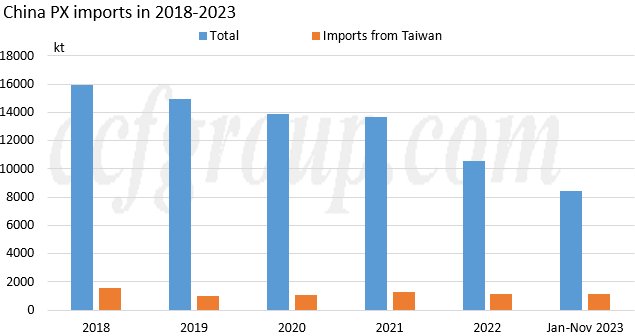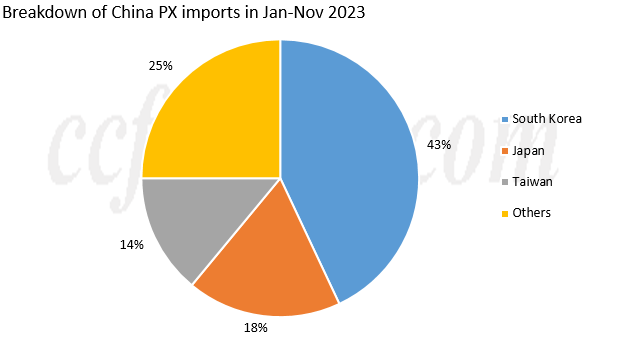Impact from tariff change on China's PX imports from Taiwan
The Tariff Commission of China's State Council has issued a notice on Dec 20, stating that it will suspend tariff concessions on certain products under the Cross-Strait Economic Cooperation Framework Agreement.
Starting from January 1, 2024, the agreement tariff rates applicable to 12 imported products including propylene, paraxylene, etc. originating from Taiwan will be suspended, and the current relevant regulations will be implemented. Specifically, the tariff for PX will be adjusted from the current 0% to 2%.
The tariff of 2% will be applied on PX imports from Taiwan, same as that from other countries and regions except for ASEAN.
There's only one PX producer in Taiwan, i.e. FCFC, and its PX exports are mainly supplied to its own PTA plant at Ningbo, Zhejiang Province, with some PX sold to other PTA plants.


From 2018 to Jan-Nov 2023, Taiwan exported an annual average of 1176kt of PX to Chinese mainland, accounting for 9.5% in average of the total, which makes Taiwan the third largest origin for PX imports of Chinese mainland.
In Jan-Nov 2023, PX imported originated from Taiwan accounted for 14% of the total, and the volume averaged 106kt per month.
After the implementation of 2% tariff, it is roughly estimated that the importing cost could increase by 24.7 million USD in 2024, based on the average importing price of $1044/mt in Jan-Nov 2023 and the annual average importing volume of 1176kt from Taiwan.
The competitiveness of Taiwan's PX is declining. Currently, the imports of PX from Taiwan enjoy a preferential policy of 0 tariff, which means that the cost of importing PX from Taiwan is relatively low. Although in actual transactions, the buying and selling parties often share the benefit of tariff reduction, buyers still have an advantage of around 1% tariff reduction compared to imports from Japan and South Korea.
With the implementation of 2% tariff, PX imports from Taiwan will no longer be able to enjoy this 1% reduction advantage, leading to an increase in the cost of importing from Taiwan. This may prompt buyers to turn to PX from ASEAN countries or imports from Japan and South Korea.
The weakened competitiveness of could lead to reduced profits. Compared to the current practice of sharing a 1% tariff advantage with other PTA plants, the cancellation of this benefit in the future will result in reduced profits. Moreover, as the most of the imports from Taiwan are used in its PTA plant in Ningbo, the imposition of tariffs will significantly increase the cost of PX used in PTA production, thereby potentially weakening the competitiveness of its PTA to some extent and possibly having a negative impact on its operating rate.
In a conclusion, the increase in import tariffs from Taiwan will significantly affect the competitiveness of PX from Taiwan, leading to increased costs and reduced profits. For other PTA plants in China, the impact is relatively limited (based on import data, approximately 20,000 tons/month of PX imported from Taiwan is sold to other PTA plants).
- Top keywords
- Cotton Price
- Cotton Futures Price
- Cotton Futures
- CZCE
- PTA Futures Price
- Chemical Fiber
- Polyester Prices
- Wool price
- PTA Futures
- Shengze Silk
- China
- Yarn Price
- price
- China Textile City
- Fibre Price
- Benzene Price
- Cotton
- Index
- Cotton Index
- PTA
- fabric price
- NYMEX
- Top 10
- textile industry
- Spot Cotton
- Cotton Yarn
- Polyester Price
- Futures
- PTA Price
- cotton yarn price

